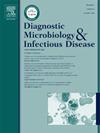Diagnosis of Cladophialophora bantiana cerebral infection by clinical metagenomics
IF 2.1
4区 医学
Q3 INFECTIOUS DISEASES
Diagnostic microbiology and infectious disease
Pub Date : 2025-03-20
DOI:10.1016/j.diagmicrobio.2025.116822
引用次数: 0
Abstract
Purpose
Cladophialophora bantiana is a rare cause of severe central nervous system phaeohyphomycosis.
Results
A 44-year-old woman from Northeastern Brazil with a history of scotomas, mental confusion, and impaired coordination presented Magnetic Resonance Imaging with vasogenic edema and nodular enhancement in the left occipital lobe. Brain biopsy showed neutrophilic exudate with eosinophils, macrophages, giant multinucleated cells, and septate hyphae with a brown-colored birefringent wall and acute angle branching. Metagenomic analysis of the biopsy's total RNA revealed the presence of RNA sequences highly similari to C. bantiana. Culture confirmed the presence of olivaceous-gray suede-like to floccose colonies, with septate dematiaceous hyphae and long conidia chains from undifferentiated conidiophores, consistent with C. bantiana.
Conclusions
This case highlights the potential of metagenomic testing as a tool for early diagnosis of infections caused by uncommon fungal pathogens. To our knowledge, this is the first report of C. bantiana central nervous system infection in Brazil.
应用临床宏基因组学诊断斑蝶猴脑感染
目的:bantiana紫丝霉是引起严重中枢神经系统褐丝霉病的一种罕见病因。结果来自巴西东北部的44岁女性,有暗斑、精神错乱和协调性受损史,磁共振成像表现为左枕叶血管源性水肿和结节增强。脑活检示中性粒细胞渗出,伴嗜酸性粒细胞、巨噬细胞、巨大多核细胞和分离菌丝,双折射壁呈棕色,呈锐角分支。活检的总RNA的宏基因组分析显示,RNA序列的存在高度相似的C. bantiana。培养证实了橄榄灰色绒样到絮状菌落的存在,具有分离的木丝状菌丝和来自未分化分生孢子孢子的长分生孢子链,与铁皮草一致。结论该病例强调了宏基因组检测作为早期诊断罕见真菌病原体引起的感染的工具的潜力。据我们所知,这是巴西首次报告bantiana C.中枢神经系统感染。
本文章由计算机程序翻译,如有差异,请以英文原文为准。
求助全文
约1分钟内获得全文
求助全文
来源期刊
CiteScore
5.30
自引率
3.40%
发文量
149
审稿时长
56 days
期刊介绍:
Diagnostic Microbiology and Infectious Disease keeps you informed of the latest developments in clinical microbiology and the diagnosis and treatment of infectious diseases. Packed with rigorously peer-reviewed articles and studies in bacteriology, immunology, immunoserology, infectious diseases, mycology, parasitology, and virology, the journal examines new procedures, unusual cases, controversial issues, and important new literature. Diagnostic Microbiology and Infectious Disease distinguished independent editorial board, consisting of experts from many medical specialties, ensures you extensive and authoritative coverage.

 求助内容:
求助内容: 应助结果提醒方式:
应助结果提醒方式:


